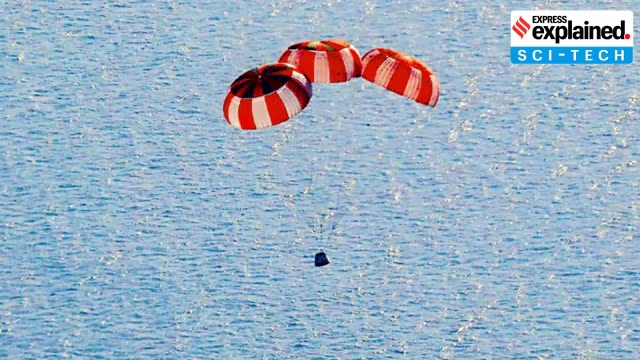ISRO’s Big Win: Gaganyaan Air-Drop Test Proves India Is Closer to Sending Humans to Space

Image via The Indian Express
Date: August 27, 2025
India took one more confident step toward space exploration on August 24, 2025. The Indian Space Research Organisation (ISRO) carried out the first Integrated Air-Drop Test (IADT-01) for the country’s ambitious Gaganyaan mission. The test was conducted at the Satish Dhawan Space Centre (SDSC) in Sriharikota and later recovered at sea with support from the Indian Navy.
This test is a milestone because it focuses on the safety of astronauts, which is the backbone of any human spaceflight programme. Without a proven parachute recovery system, no crew can be declared safe to return home. That is why this trial was so crucial.
What Happened During the Air-Drop Test?
The trial was designed to mimic what will happen when the crew module returns from orbit.
- A Chinook heavy-lift helicopter of the Indian Air Force carried a 4.8-tonne dummy crew module high up in the sky.
- The helicopter climbed to an altitude of about 3 kilometres and then released the module in mid-air.
- The module then relied fully on its onboard avionics and parachute systems to slow down.
- The descent was carefully tracked from land, air, and sea.
Finally, the module splashed down in the Bay of Bengal at a safe speed. The recovery team pulled it onto the Navy ship INS Anvesha and brought it back to Chennai Port.
Step-by-Step Parachute Sequence
The highlight of this test was the complex parachute system. It is the first full demonstration of how Gaganyaan’s crew will come back safely.
- Apex Cover Separation (ACS) Parachutes – Two small 2.5-metre chutes fired first. They opened the nose cover of the module.
- Drogue Parachutes – Next, two large 5.8-metre chutes deployed. These stabilised the capsule and reduced its high fall speed.
- Pilot Parachutes – Then, three pilot chutes of 3.4 metres each came into action. Their role was to pull out the heavy main parachutes.
- Main Parachutes – Finally, three giant parachutes of 25 metres each opened. They brought down the fall speed to about 8 metres per second, which is safe for a water landing.
Every stage worked exactly as planned. For ISRO engineers, this was the most satisfying outcome, because even a small error in parachute deployment could put astronauts at risk.
Why Is This Test Crucial for Gaganyaan?
ISRO cannot risk sending humans into space until every safety system is tested. The air-drop test has multiple reasons why it is considered a turning point:
- Checks Astronaut Safety: The parachute recovery system ensures astronauts can land safely even after a high-speed re-entry.
- Validates Abort Scenarios: If there is an emergency during launch, the crew module may have to be separated and dropped. This test shows it can land without harm.
- Builds Confidence: Success here gives confidence for future uncrewed and crewed flights.
- Global Standards: Every major space agency, like NASA and Roscosmos, has carried out similar tests before flying humans. India is now at that stage.
- Boosts Timeline: With IADT-01 done, ISRO can now move toward the next test missions without delay.
Who Made This Test Possible?
The test was a joint operation involving several arms of India’s science and defence ecosystem.
- ISRO designed and executed the test.
- DRDO’s Aerial Delivery Research and Development Establishment (ADRDE) built the parachutes and pyrotechnic devices.
- Indian Air Force provided the Chinook helicopter that dropped the crew module.
- Indian Navy and Coast Guard managed recovery operations in the Bay of Bengal.
This teamwork proves that Gaganyaan is not just an ISRO mission, but a national mission involving multiple forces.
Gaganyaan Timeline: What’s Next?
ISRO has been steadily preparing for Gaganyaan with a series of tests:
- October 2023 – TV-D1 Mission: Crew escape system tested successfully.
- August 2025 – IADT-01: First air-drop test of the recovery parachutes.
- Late 2025 – TV-D2: Another abort test to validate crew escape in different scenarios.
- Late 2025 – Gaganyaan-1 (G-1): First uncrewed orbital mission.
- 2026 – Gaganyaan-2 (G-2): Second uncrewed orbital mission.
- 2027 – Crewed Mission: India’s first astronauts to space in an Indian spacecraft.
This path shows how carefully ISRO is moving step by step, ensuring that no risks are left unchecked.
How Does This Compare with Other Countries?
India is only the fourth country after the USA, Russia, and China to plan human space missions.
- NASA’s Apollo missions in the 1960s also used similar air-drop parachute tests before sending astronauts to the Moon.
- Russia’s Soyuz capsules still depend on parachutes for safe landings on land.
- China’s Shenzhou spacecraft also went through parachute recovery trials before its first crewed flights.
By achieving IADT-01, India has placed itself in the same league as these space giants.
Challenges Ahead for ISRO
Even though the air-drop test was successful, challenges remain:
- Heat Shield Testing: The crew module must survive scorching heat during atmospheric re-entry.
- Life Support Systems: Engineers are working on systems to provide oxygen, food, water, and temperature control inside the capsule.
- Astronaut Training: Indian astronauts are being trained in Bengaluru and Russia for survival and space operations.
- Complex Launch Operations: Every rocket launch is risky. ISRO must prove the reliability of its human-rated GSLV Mk-III rocket.
Only after passing all these hurdles can ISRO confidently put astronauts onboard.
Why It Matters for India
The Gaganyaan mission is not just about prestige. It has deeper impacts:
- Scientific Growth: Builds cutting-edge technology in avionics, material science, robotics, and life sciences.
- Global Partnerships: Opens doors for India to join more global missions, including Moon and Mars exploration.
- Defence & Security: Strengthens India’s space capabilities, which also have national security benefits.
- Inspiration: Motivates a new generation of Indian students to take up science and engineering.
- Economic Boost: Creates high-tech jobs and supports local industries making components for spaceflight.